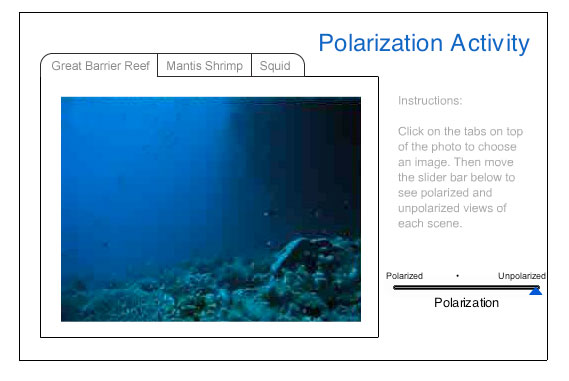Sunglasses in the Sea
When sunlight passes through or bounces off objects, the intensity and color of the light can change. One example of this is the bright reflection called glare, created when sunlight hits flat, shiny surfaces like asphalt or water. Drivers and fishermen can reduce the glare that reaches their eyes by wearing polarizing sunglasses. These sunglasses are filters—they transmit some light rays, but block others.
In the sea, sunlight and bioluminescent light are also bent, reflected, and scattered when they hit seawater, the bottom, and even the skin, scales, and bodies of living creatures. And many marine animals have polarizing lenses in their eyes—lenses that manipulate the passage of light and control the animal's view of the world, just like a pair of polarizing sunglasses does for humans.
In the photos below, compare polarized and unpolarized views of marine life, and evaluate how organisms utilize tricks of light and lenses to communicate, hunt, and hide by answering the questions that follow.
Questions
- Compare these two views of the Great Barrier Reef. What benefit does an animal get from having polarizing lenses in its eyes?
[Check Answer]
A creature with polarizing lenses in its eyes can see farther and more clearly.
- Look closely at the images of the mantis shrimp. The shrimp on the left is a male, and the one on the right is a female. Describe any differences between their polarized and unpolarized appearances.
[Check Answer]
The shrimp have colored appendages in the front - in the polarized view the male's paddle changes color to a bright red, while the female's paddle stays the same color.
- Who do you think is most interested in the difference, other mantis shrimp or predators and prey of the shrimp?
[Check Answer]
The color change visible with polarized lenses is gender-based, so it seems likely the shrimp use it to distinguish males and females. It might be used to attract mates or mark territory. Other species probably don't care whether the shrimp they eat or that eats them is male or female.
- What does this tell you about the mantis shrimp?
[Check Answer]
The mantis shrimp must have polarizing lenses in their eyes, so that they can see the red color of the males.
- Now, compare the polarized and unpolarized views of the squid.
[Check Answer]
In the unpolarized view, the squid is nearly transparent. But seen through a polarizing lens, the outside of the body and especially some of the tentacles show up very clearly.
- Who is more likely to be interested in the view of the squid with polarizing lenses, other squid or the predators and prey of the squid?
[Check Answer]
The squid is practically invisible in the unpolarized view. It would be easy for it to sneak up on prey, and it would be hard for a hunter to capture it. Animals with polarizing lenses would have a much better chance of seeing the squid, and either eating it or escaping from it.
Critical Thinking
Few land animals are transparent, but many marine animals are, like the squid shown above. Why?Scientists seek to understand and explain how the natural world works. Many of the questions raised in this endeavor have no absolute answers.
Almost all animals need to hide at some point in their lives—some just when they are young, small, and weak, others whenever they want to avoid predators or keep prey from escaping. Land animals can take advantage of the landscape, and hide under a rock or in some bushes. Even flying creatures can sometimes perch in a leafy tree or take shelter in a cave. But in the open sea, there is nothing to hide behind, below, or within. Animals that live in water are exposed and vulnerable from all sides. And so many are transparent. With their bodies almost as clear as glass, these creatures are able to hide in plain sight.
Related Links
Multimedia Discovery Missions: Lesson 6 - Deep-Sea Benthos


